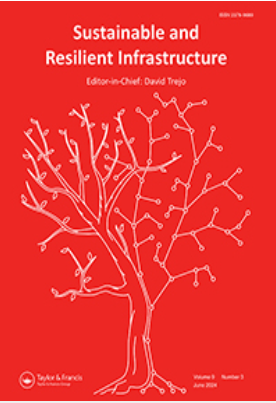A novel method for quantifying risks to climate change events using conditional value at risk: a multi-unit residential building case study in London, Ontario
IF 2.2
Q2 ENGINEERING, CIVIL
引用次数: 0
Abstract
ABSTRACTClimate change may lead to more frequent and severe weather events, resulting in significant financial and human health impacts. This paper develops a risk metric using building performance simulation by associating thermal and incidental risks in buildings during power outages while considering multiple cold and hot events. Conditional Value at Risk (CVaR) is calculated using variations in outage events. According to the results, employing an integrated building design and a microgrid with photovoltaic panels that can be disconnected from the grid halves vulnerability related to ice storms and completely mitigates it for historical heatwave events. The variability study has revealed that a code-minimum design has eight times the CVaR of the as-built design. This novel methodology has the potential to inform future environmental, social, and corporate governance strategies and assist infrastructure operators in managing their risk exposure to future climate change events, considering various types of risks and multiple hazards.KEYWORDS: Riskthermal resilienceincidental damagesadaptationzero-net-energy Disclosure statementNo potential conflict of interest was reported by the author(s).Correction StatementThis article has been corrected with minor changes. These changes do not impact the academic content of the article.Additional informationNotes on contributorsMilad RostamiMilad Rostami is currently a Ph.D. student in Building Engineering at Carleton University. He earned his Master of Science degree in Civil Engineering from the University of Tehran. His research interests encompass climate change adaptation, risk analysis, and building performance simulation.Santinah Green-MignaccaSantinah Green-Mignacca is pursuing a Master's degree in Building Engineering at Carleton University. She holds a Bachelor's degree in Architectural Conservation and Sustainability Engineering, also from Carleton University. Her research interests include sustainable infrastructure, resilience and adaptation strategies, as well as biophilic design.Scott BuckingScott Bucking is an Associate Professor in the Department of Civil and Environmental Engineering at Carleton University. He completed his Ph.D. in Building Engineering at Concordia University. His research focuses on areas such as net-zero energy buildings, building performance simulation, and climate change resilience.一种利用风险条件值量化气候变化事件风险的新方法:安大略省伦敦多单元住宅楼案例研究
气候变化可能导致更频繁和更严重的天气事件,造成重大的经济和人类健康影响。本文在考虑多种冷热事件的同时,通过将停电期间建筑物的热和附带风险联系起来,开发了一种使用建筑性能模拟的风险度量。条件风险值(CVaR)是使用中断事件的变化来计算的。根据研究结果,采用一体化的建筑设计和带有光伏板的微电网(可以与电网断开),可以减少与冰暴相关的脆弱性,并完全减轻历史热浪事件的脆弱性。变异性研究表明,代码最小设计的CVaR是建成设计的8倍。这种新颖的方法有可能为未来的环境、社会和公司治理战略提供信息,并帮助基础设施运营商在考虑各种类型的风险和多重危害的情况下管理未来气候变化事件的风险。关键词:风险热弹性附带损害适应性零净能耗披露声明作者未报告潜在利益冲突这篇文章经过了细微的修改。这些变化不影响文章的学术内容。作者简介:milad Rostami目前是卡尔顿大学建筑工程专业的博士生。他在德黑兰大学(University of Tehran)获得土木工程硕士学位。他的研究兴趣包括气候变化适应、风险分析和建筑性能模拟。Santinah Green-Mignacca正在卡尔顿大学攻读建筑工程硕士学位。她拥有卡尔顿大学建筑保护和可持续发展工程学士学位。她的研究兴趣包括可持续基础设施,弹性和适应策略,以及亲生物设计。Scott buckking是卡尔顿大学土木与环境工程系的副教授。他在康考迪亚大学(Concordia University)完成了建筑工程博士学位。他的研究主要集中在净零能耗建筑、建筑性能模拟和气候变化适应能力等领域。
本文章由计算机程序翻译,如有差异,请以英文原文为准。
求助全文
约1分钟内获得全文
求助全文
来源期刊

Sustainable and Resilient Infrastructure
ENGINEERING, CIVIL-
CiteScore
7.60
自引率
10.20%
发文量
34
期刊介绍:
Sustainable and Resilient Infrastructure is an interdisciplinary journal that focuses on the sustainable development of resilient communities.
Sustainability is defined in relation to the ability of infrastructure to address the needs of the present without sacrificing the ability of future generations to meet their needs. Resilience is considered in relation to both natural hazards (like earthquakes, tsunami, hurricanes, cyclones, tornado, flooding and drought) and anthropogenic hazards (like human errors and malevolent attacks.) Resilience is taken to depend both on the performance of the built and modified natural environment and on the contextual characteristics of social, economic and political institutions. Sustainability and resilience are considered both for physical and non-physical infrastructure.
 求助内容:
求助内容: 应助结果提醒方式:
应助结果提醒方式:


